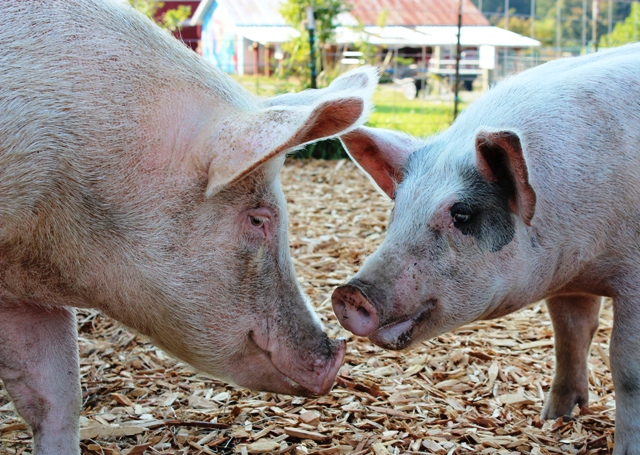The quarter is in full swing, which means that teaching has completely absorbed my time and energy. Amazingly, the class has remained full and the students for the most part all seem engaged. It is so exciting to hear their ideas about the readings and watch as their thoughts shift and evolve with the material we encounter for the class. This week is animal emotion week. We read a couple of articles by Marc Bekoff on animal emotion and on scientific methods. He makes a case for valuing alternative methods of understanding animal emotions—namely, that in the case of the study of emotion, anecdote is paramount. Anecdote is generally thought of as being ‘soft’ science or somewhat squishy, less rigorous science. On the contrary, Bekoff argues that it is one of the only ways we can begin to understand the rich emotional lives animals lead.
Yesterday in class, we watched two films about animal emotion. One goes along with The Pig Who Sang to The Moon by Jeffrey Moussaieff Masson, the book we’re reading for Wednesday. This film is 52 minutes and follows Masson’s journey to various sanctuaries to attempt to understand farmed animal emotion. It’s called The Emotional World of Farm Animals.
This other one is quite short, only 12 minutes, and is worth the watch. It’s called “Shirley’s Story” and it’s a beautiful story about an elephant.
I heard more than a few sniffles in the room yesterday as we were watching these films—not because they’re painful to watch, but because of the beauty of witnessing and taking seriously the emotional lives of other animals. We had a short discussion about the films yesterday, but I’m looking forward to digging into a real discussion with the class tomorrow. This week is in preparation for a class field trip to Pigs Peace Sanctuary this weekend, where they will get to spend some time with some pigs and see how emotional they can be. Then next week, we start reading about slaughter.
This past week has been a bit rough for a number of reasons, but the one I’ll share now is that I attended another auction with a group of students from the class. It was a different auction than the one I visited before, and they auctioned off pigs, sheep, goats, calves, cows, and steer all in one auction. The piglets came in first and the people who were herding them in the pen struck them in face with paddles and grabbed them by their back legs and picked them up impatiently to get them to go through the exit door after they were auctioned. A few of them were body-slammed into the wall by the men. The pigs squeeled loudly every time they were struck in the face or handled roughly. If you were paying attention, it was clear that they were terrified and in pain. And speaking of emotions, I found myself shutting my own emotions off immediately, knowing I had to get through another hour of this, and knowing that I had to hold it together to be able to answer any questions the students had.
The auction continued, and the usual suspects came through the pen—emaciated cows used up by the dairy industry, organic and non-organic steers who would be slaughtered for organic and non-organic ‘beef’, pregnant cows who were being sold based on the fact that they were due to deliver calves ‘just after the New Year’…But this time, there was one animal I had not seen at the other auctions. When he first came into the pen on wobbly legs, I thought “Why is there a deer at the auction?!” And then slowly, with horror, I realized he was a day-old calf. He was a Jersey breed calf, so he was a creamy brown color like the coloring of a deer with big dark eyes. His umbilical cord was still attached. It dangled, drying and shrivelled from his stomach. He was tiny and beautiful, the size of Maizy (our yellow lab), and thin. He was silent as he looked around trying to understand where he was. He sold for $15.
I’ve been thinking about what emotions that calf must have experienced being taken away from his mother on the day after he was born. He must have been terrified and confused and so lonely. I’ve been thinking about what the cow who is his mother must be feeling. When I visited a small-scale dairy farm, the farmer said that it’s common for cows to bellow for two weeks after their calves are taken from them. Is she crying for her calf now, wondering where he is and why he’s not with her?
Emotions are the reason why we do the work we’re passionate about. Empathizing with others is a deeply emotional experience. We are all emotional animals and this week in class is all about understanding that and thinking about what it means. What does is mean that cows are deeply emotional beings and why does this matter? How are our own emotions important in our relationships with other animals? And in what ways is emotion a powerful catalyst for change?

 Follow
Follow
